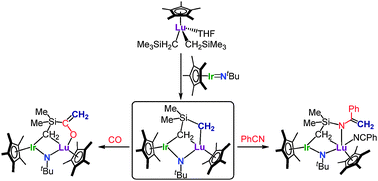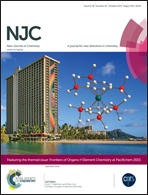Rare-earth–iridium heterobimetallic complexes with bridging imido and silylmethyl ligands: synthesis, structure and reactivity†
Abstract
The reaction of the half-sandwich lutetium dialkyl complexes [(C5Me4R)Lu(CH2SiMe3)2(THF)] (1-Lu: R = Me, 1′-Lu: R = SiMe3) with 1 equiv. of the iridium imido complex [Cp*IrNtBu] (Cp* = C5Me5) gave the corresponding imido- and silylmethyl-bridged heterobimetallic Lu–Ir complexes [Cp*Ir(μ-NtBu)(μ-CH2SiMe2CH2)Lu(C5Me4R)] (2a: R = Me, 2b: R = SiMe3), with the release of SiMe4 through C–H bond activation (hydrogen abstraction) of a methyl group in one CH2SiMe3 group by another CH2SiMe3 group. A similar reaction of the scandium dialkyl complex [Cp′Sc(CH2SiMe3)2(THF)] (1-Sc) (Cp′ = C5Me4SiMe3) with [Cp*IrNtBu] yielded the imido- and trimethylsilylmethylidene-bridged Sc–Ir complex [Cp*Ir(μ-NtBu)(μ-CHSiMe3)ScCp′] (3) through the C–H bond activation of the α-CH2 unit in a CH2SiMe3 group. Recrystallization of 3 from toluene in the presence of pyridine gave the pyridine-coordinated complex [Cp*Ir(μ-NtBu)(μ-CHSiMe3)Sc(NC5H5)Cp′] (3′). The reaction of the Lu–Ir heterobimetallic complex 2a with two equivalents of PhCN afforded the enamido complex [Cp*Ir(μ-NtBu)(μ-CH2SiMe2)N(C(![[double bond, length as m-dash]](https://www.rsc.org/images/entities/char_e001.gif) CH2)Ph)Lu(PhCN)Cp*] (4) through the insertion of one molecule of PhCN into the terminal Lu–CH2 bond in 2a and the coordination of another molecule of PhCN to the Lu atom. The intramolecular nucleophilic addition of the enamido unit to the coordinated PhCN in 4 then yielded the diazalutenacyclohexadienyl complex [Cp*Ir(μ-NtBu)(μ-CH2SiMe2NC(Ph)CHC(Ph)NH)LuCp*] (5) after isomerization (1,3-hydrogen shift). The reaction of 2a with carbon monoxide (1 atm) at room temperature afforded the enolate complex [Cp*Ir(μ-NtBu)(μ-CH2SiMe2C(
CH2)Ph)Lu(PhCN)Cp*] (4) through the insertion of one molecule of PhCN into the terminal Lu–CH2 bond in 2a and the coordination of another molecule of PhCN to the Lu atom. The intramolecular nucleophilic addition of the enamido unit to the coordinated PhCN in 4 then yielded the diazalutenacyclohexadienyl complex [Cp*Ir(μ-NtBu)(μ-CH2SiMe2NC(Ph)CHC(Ph)NH)LuCp*] (5) after isomerization (1,3-hydrogen shift). The reaction of 2a with carbon monoxide (1 atm) at room temperature afforded the enolate complex [Cp*Ir(μ-NtBu)(μ-CH2SiMe2C(![[double bond, length as m-dash]](https://www.rsc.org/images/entities/char_e001.gif) CH2)O)LuCp*] (6), which upon reaction with PhCN gave an adduct complex [Cp*Ir(μ-NtBu)(μ-CH2SiMe2C(
CH2)O)LuCp*] (6), which upon reaction with PhCN gave an adduct complex [Cp*Ir(μ-NtBu)(μ-CH2SiMe2C(![[double bond, length as m-dash]](https://www.rsc.org/images/entities/char_e001.gif) CH2)O)Lu(NCPh)Cp*] (6′) through coordination of PhCN to the Lu atom. The reaction at the bridging imido ligand NtBu was not observed in any case.
CH2)O)Lu(NCPh)Cp*] (6′) through coordination of PhCN to the Lu atom. The reaction at the bridging imido ligand NtBu was not observed in any case.

- This article is part of the themed collection: Frontiers of Organo-f-Element Chemistry

 Please wait while we load your content...
Please wait while we load your content...